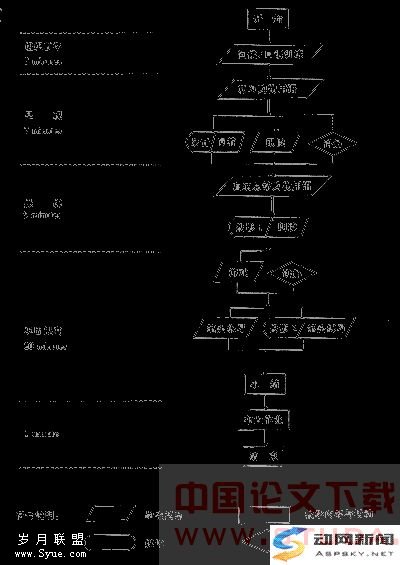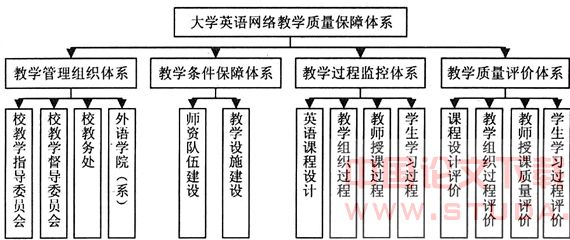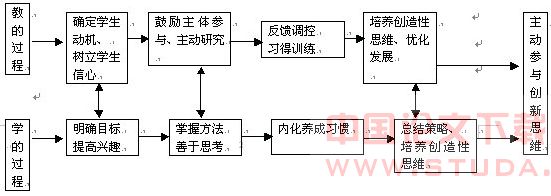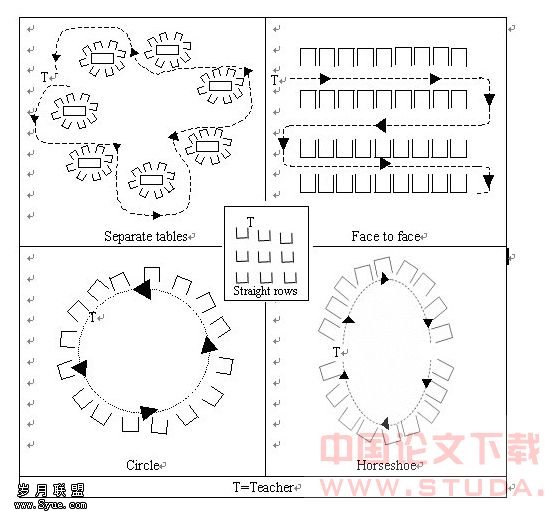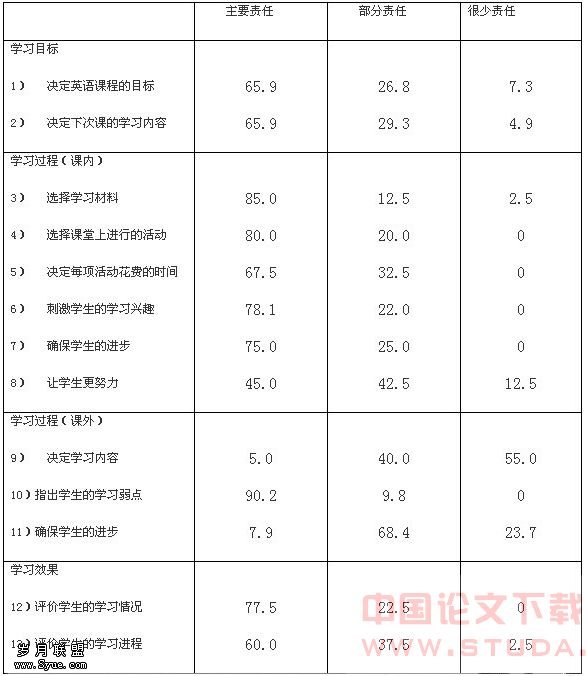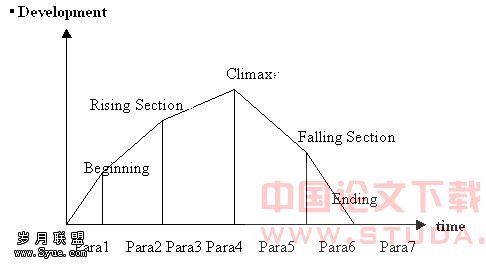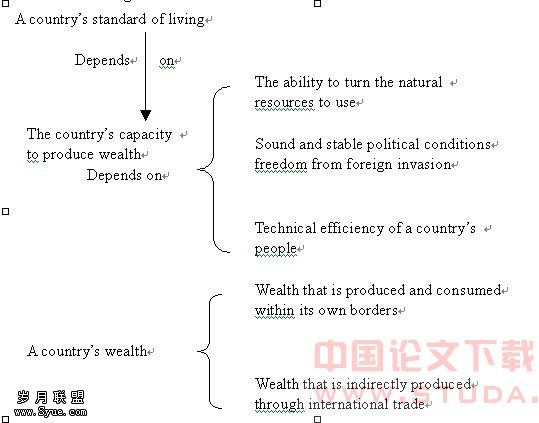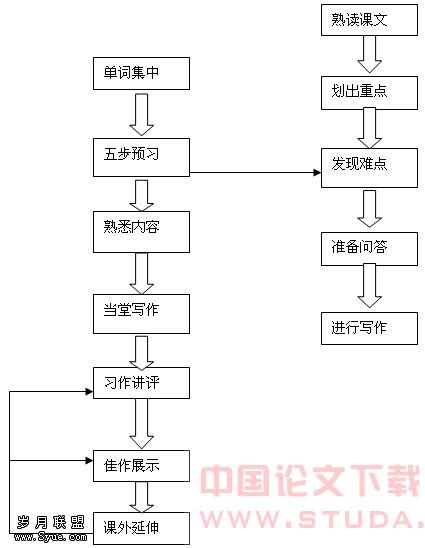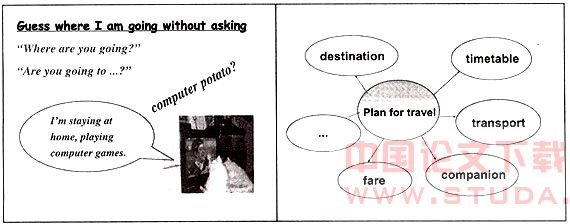中学英语教学与跨文化交际能力培养
As we know, with the rapid development of technology and society, the globalization is the main-stream of world development. Because of the frequent communication and close connection between the people all over the world, and especially after China entered the WTO, foreign languages are used more and more widely. During the cross-cultural communication, if one is ignorant of the culture and customs of the other, he or she is surely unable to have a good understanding of the other and can’t carry on the communication further. As English is the most widely used language, it’s quite necessary for us to know the culture and customs of the people of the English-speaking countries. That’s the reason why we need not only to improve the language skills, but also to cultivate the studentes’ abilities of the cross-cultural communication.
This paper mainly deals with the relationship between the language and culture, the necessity of cultural education, the principles and content of cultural teaching and how to build the students’ cross-cultural abilities in middle school English teaching.
[Key Words] intercultural communication; English teaching; cultural introduction; cultural knowledge
[摘 要] 在传统的教学中,诸如词汇、短语、语法等英语知识内容受到了广泛的关注,而英语作为一个民族语言的文化背景却被大大地忽略了。结果,学生学了几年英语,对英语和母语之间的文化差异,以及说英语民族的风俗习惯仍一无所知。从而,在与外国朋友的交际中,出现过许多偏差,误解,甚至笑话。
众所周知,随着科技的飞速进步和社会的迅猛,世界正向全球化和一体化发展。世界各国人民日益频繁的交往和更加紧密的联系,特别是加入世贸之后与外界交往的加强,使外语的使用也变得越来越频繁和广泛。不同文化背景的人们在相互交际中回避不了文化差异问题。在交际的过程中,人们如果不了解对方的文化和风俗习惯,就不可能进行有效的交际。英语是世界上使用最广的语言,中国人要学会用英语进行交际,就必须了解英语国家的文化,特别是交际文化。因此,英语教学不仅要提高学生的语言能力,还要提高学生的跨文化交际能力。
本文分为五个部分:第一部分简单介绍了语言和文化的关系;第二部分阐明了在中学英语教学中进行文化的必要性。第三部分讲述了实施文化教学的过程中所应遵守的原则。第四部分分析了进行跨文化交际能力培养所应导入的文化内容。第五部分说明了在中学英语教学过程中怎样实施跨文化教育的途径和具体方法。
[关键词] 跨文化交际; 英语教学;文化导入;文化知识
1. Introduction
Language is just like a mirror that reflects its national culture. Sociologists and anthropologists believe that culture comprises all products of human activity, including fields of literature, art, music, architecture, philosophy, scientific and technical achievements as well as aspects of customs, life-style, code of conduct, worldly wisdom and social organization, etc. Languages are generally accepted words and rules drawn from speech. Language is the carrier of culture and culture is the content of language. There is no language without culture content. Therefore learning culture knowledge has become a major part of teaching English to Chinese students. International communication is communication between people whose culture perception and symbol systems are distinct enough to alter the communication event.
Worldwide interest in intercultural communication grows out of two assumptions. First, we live in an age when changes in technology, travel, economy, and political systems, immigration patterns, especially the emergence of Internet, have created a world in which we increasingly interact with people from different cultures. And whether we like it or not, these interactions will continue to grow in both frequently and intensely. Second, people now know that the influence of culture affects communication in a subtle way. Our culture perceptions and experiences help determine how the world looks and how we interact in the world.
However, as we look back to see the situation in China’s schools. We see that, for several decades, language teachers have not been able to pay attention to the role of culture knowledge in language learning. Nowadays, in English teaching, especially in middle school, teachers pay much attention to vocabulary and grammar.
As Chinese culture is not the same as that of English-speaking countries, the rules for using Chinese are, in some respects, different from those using English. There is especially good evidence that Chinese students may transfer their mother tongue references of language used to their English performance and fail to communicate effectively. Misunderstanding caused by cross-cultural communication should break down and much attention should be paid to them in English language teaching.
So in middle school English teaching, teachers must not only train and improve students’ language level, but also pay attention to cultivating students’ abilities of intercultural communication.
2. Significance of cultivating the abilities of cross-cultural communication
2.1 The request of the development of Internationalization
Lin Dajin in the "cross-cultural communication study," pointed out that culture can be defined as " the integrated feature that a nation is distinct from another nation." Cultural differences are the barriers of cross-cultural communication. The modernization process accelerated the circulation of spiritual and material products, and brought all nationalities into a common "global village", [1] cross-cultural communication became an integral part of national life. If people do not understand the cultural convention in the USA or Britain, and use the way of China to treat foreigners, then it will create a lot of jokes, and even hurt each other's feelings, self-esteem and cause misunderstanding. Thus, to overcome the cultural differences caused by communication barriers has become a common problem faced by the entire world.
2.2 It is imperative to understand the cultural background knowledge
Understanding cultural knowledge is the key to language learning. “One can not really learn the language, and teach language well unless one knows the patterns and norms of culture and cultural background (Song Fei, 1998)." [2] Without a specific cultural background, language is non-existent. If we don’t know the culture of target language, we would find it is difficult to understand the meaning of certain words. For example, “Thanksgiving", "Sandwich" has been brought about in a specific social and historical circumstance, it is not enough merely to know the meaning of the surface of these words. Another example is: “You are, indeed, a lucky dog", the literal translation is "you are a lucky dog." This is a satiric sentence in China, because, in Chinese views, "dog" is an expression when people used to refer generally to dislike someone. While in English, it can mean, "You are a lucky man." In Western society, "dog" is a family member, and they are harmonious coexisting with people "Dog" here refers to people instead of satirizing others, but a very intimate expression. [3]
2.3 Cultural knowledge teaching is the objective of language teaching.
The main objective of language teaching is to train and develop students’ interpersonal skills. And cultural knowledge teaching can increase the ability of cross-cultural communication, which is the important content to achieve goals of language teaching. For example, in American society, praise and compliments language that flatter mainly a personal appearance, new things, personal property, and individuals in a certain area are commonly used as the introduction to a conversation. This is different from Chinese. Thus, different nations have different cultural environments, different living habits and different languages behavior expressions. And as a language learner, if not ideologically “physically entering their social linguistic environment” will be difficult to achieve the goal of language learning,not to say that language teaching objectives will be accomplished.[4]
3. Principles of culture teaching.
The foreign language teaching in middle school is the foundation of our country’s foreign language teaching. As an English teacher, one should provide the most useful cross-culture knowledge in the limited teaching life.
Just as what we mentioned above, we have been aware of the importance of learning some cultural knowledge about the target language. It seems impossible and unnecessary for us to have a systematic study of target culture, which covers almost everything, in one’s whole lifetime. The difficulty shows that culture is ubiquitous, multidimensional and complex. A good solution to this problem might be to learn selectively those cultural factors that have great influence on intercultural communication, and that are closely related to the language. So on culture teaching we should follow these principles :( 1) Interrelated [5]. that is culture teaching must be interrelated with the content of the text. (2) Appropriate, that is culture teaching must be subjected to language teaching. (3) Practical, that is culture teaching must try to be “useful” for students in their communication. (4) Scientific, that is culture knowledge must be taught correctly, completely and objectively. (5) Flexible [6] ,that is culture teaching must be flexible according to the change of the world.
We must obey these five principles if we want to cultivate students’ abilities of cross-cultural communication. What we should teach in ELT classes is simply a foreign way of life related to the target language and teachers should avoid bringing their own cultural prejudice into class. The world is changing, so are the traditions and customs. The constant changes require us to improve our skills of intercultural communication by doing two things: understanding the cultural differences, especially the differences in the deep structure of different cultures, and becoming flexible in intercultural communication. There is a great tendency that one culture adopts the elements from another that are compatible with its own values and beliefs or that can be changed without causing major disruption.
4. Content of culture introduction
English teaching in middle school is the foundation of foreign language teaching in our country, so English teachers should provide the most useful knowledge of cross-cultural communication in their limited teaching period.
4.1 The content of intercultural communication
Generally, teaching content is based on certain syllabus, but now because culture introduction is a new issue, so we have neither specifical teaching materials nor specialized classes. What we can do is to mention it when it appeared, so it is very arbitrary and relatively loose. Professor Hu Wenzhong integrated the existing achievement of language and culture studies, and divided the teaching of cultural content into five aspects: language communication, non-verbal communication, communication customs and etiquette, social structure and human relationships and values. Secondary English teachers can base on these five aspects in ing, speaking, reading and writing to teach and guide students.
4.2 Content of intercultural communication in listening, speaking, reading, and writing.
4.2.1 Listening
Broadly speaking, listening is a process that listeners hear the voice and decipher them to semantic meanings. It needs to have not only the relative knowledge of words, tone, grammar, and so on, but also knowledge of the socio-cultural knowledge. Whether listeners have the knowledge is the key to achieve the listening comprehension. Such knowledge is common knowledge, beliefs and experiences of each communicator. If one neglects these existing cultural differences, he or she will have some obstacles to listen, because English listening is understood by the hearing stimulated the cranial nerve, and the impression left as the sole basis for reflection. [7]
We cannot understand the meaning of listening material by English words, phrases or groups of semantic rank order. What we should do is to lessen the gap of mentality difference in order to adapt to the English sentence structure rapidly and accurately while we are listening, and understand the English language habits. Whether students understand the intent of the speaker or writer depends on their level of language, and also depends on if students master the words involved in the social and cultural knowledge. [8]
The purpose of listening is to understand the speaker’s real meaning in words and exchange information successfully. Sometimes the learner only catches the denotation of the words, but fail to consider the most important part, which is the contextual meaning of words and sentences. For instance, the sentence “ I am not sure I’d like to do that” is seemingly like considering a matter, but in fact, it is a polite expression of refusal.
Since we are teaching our students English not only to help them pass exams, but also to prepare them to use English in real life, it is important to think about the situation they will listen to English in real life and to think about the listening exercises we do in class. So we must tell them about some culture knowledge for them to use in real life and know more about foreign life. [9]
4.2.2 Speaking
The ultimate goal of foreign language teaching is using language to communicate and exchange information, so when we communicate with the people from English-speaking countries, we must pay special attention to some interference factors in cultural exchanges. For example, social norms which people must obey when they communicate with each other, including some rules and customs, such as the terms of the title, greetings, inquirements, apologia, thanks, telephone, parting; Social knowledge refers to the relationships between the family members, colleagues, friends, higher and lower levels; Values, including the relationship between people and nature, religious values, ethics and outlook on life, their world view, such as Western society emphasizes the individual struggle, independence, privacy, etc.; The characteristics of thinking , which means the differences of the characteristics of thinking between westerners and easterners. When they express time and place, one is from small to large, the other is from large to small. [10]
English speakers attached great importance to privacy when there are dealing with contact process, particularly between the less familiar people. It is necessary to avoid asking others affair, and sometimes even in the eyes of Chinese people for kind, caring, but for the people from the English-speaking countries, maybe it is impolite, sometimes it will cause displeasure, embarrassment and dissatisfaction. Here are three questions: (1) What’s your name? (2) How old are you? (3) Are you married? [11] Any one who knows little English can ask these questions in English. But if a student asks a young lady from a western country the above questions, he has made a serious mistake in terms of appropriacy. To avoid such silly mistakes, the teacher should help students realize that it isn’t polite to ask westerners questions concerning the age, income, marital status, and other private things, such as religious belief, political inclination, etc.
Some of the daily English expressions are deliberately vague. For example, a person in the gathering may say, “I’d better be going now. I've got a little headache.” He might want to depart or not want to stay here any more. By this time, you would not have the habit of Chinese people to ask him how he feels. If he really feels uncomfortable he will say straightly.
English reading ability is a comprehensive ability. If one wants to read an article, find out the main idea, use the information provided by the articles for inference, judgment, reasoning, he or she must master not only English language knowledge, but also a certain degree of expertise or background knowledge. When students were reading an article, although they didn’t encounter a new word, had no grammatical obstacles and understand the literal meaning of each sentence, they cannot understand the overall effect of the article content and the main idea. Because when students were reading, they always considered English equal as their mother tongue, or affected by the traditional culture of the mother tongue, intentionally or unintentionally to treat the context and meaning of these two cultures equally, so some errors of judgments will happen. Therefore, when we are training students’ reading abilities, we must base on training them to understand the whole passage or paragraph so that they can understand and become familiar with the material and cultural significance related to certain social background; understand the author's tone; be familiar with the article style and writing tendencies, correctly understand the true meaning of the text, and choose the correct answer. [12]
The learner’s lack of cultural background knowledge often hinders their comprehension in reading. For example, we mean pornographic by the word “huang” in Chinese, but in English, “blue” is taken instead of “yellow”. If learners don’t know, they will not understand what “blue film” or “blue video tapes” mean though the words are easy. This illustrates that words’ connotation is the result impact by language. So more attention should be paid to cultural background in learning idioms and literary works, otherwise, we have no means of understanding the implication of words and passage correctly.
4.2.4 Writing
In writing, the differences between the Chinese and western modes of thinking play an important part. Chinese are accustomed to thinking in a spiral way, while English and Americans in a linear way. This difference in thinking often leads to misunderstanding. Sometimes a learner’s composition is perfect in terms of grammar and logic, but when a foreigner reads it, he or she may misunderstand the original meaning of the sentences. [13]
In written expression, the Sino-British cultural differences are primarily in terms of cultural connotation. In different cultural backgrounds, some words have different meanings. In the writing process, students must pay much attention to them. For example, the Chinese used dragon as an analogy to courage and auspice, while to Europe and the U.S. people, ferocious dragon is a symbol of the disaster; Chinese has the saying that "When a rat runs across the street, everybody cries, ‘kill it!’” from this one may draw a conclusion that the Chinese people hate rats, but Disney introduced Mickey into his paradise to make it become a household love animals; [14] Chinese use “red eyes” to express “envy” while English use “green with envy”. [15]
When teachers train students written expression skills, they must contrast these cultural differences between China and Britain; otherwise, the students’ misunderstanding the culture, in a sense, is more serious than making errors in language.
5. The approaches to develop intercultural competence
Cultural teaching methods are diverse. The primary task of teachers is using various methods to teach culture and to improve students’ sensitivity to culture and cultivate cultural awareness, so that they can initiatively and willingly absorb it and involve in the new cultural environment.
5.1 Exploring existing materials’ enlightening points about the cultural knowledge.
We should as much as possible keep an eye on the implicit cultural phenomenon of materials, consider these enlightening points of cultural knowledge as the premise to expand appropriately, and try our best to express what their cultural values should be. [16] In other words, we should introduce students to the relevant cultural background knowledge, but also actively guide them to analyze, identify, develop what is useful or healthy and discard what is not for all kinds of social ideology and cultural ideas and cultural concepts. Accumulating these enlightening points about the cultural knowledge will make students benefit. It has stressed the “attention” because in many educational materials, a lot of cultural knowledge is potential, and it is not easy to grasp. It is requiring teachers to have a certain level of cultural understanding and cultural sensitivity. And to achieve this, teachers should do much more work in lesson preparation. In order to continuously improve their own ideological and theoretical level and integrated cultural accomplishments, teachers should make "exploring cultural knowledge enlightening points” as a necessary teaching basic skill.
For example, in the students’ book of Junior English 7A, unit3 which is published by oxford press, the word “dragon” (Long) appears in the teaching material. The material teaches students to celebrate the Dragon Boat Festival. Teachers can seize this cultural knowledge to point out different cultural connotations of "dragon". Dragon in the eyes of Chinese people is an auspicious animal. There is a saying: everyone hopes his or her children to be a dragon. That means, “to with one's children have a bright future”. Dragon is a symbol of China's feudal dynasty era of imperial authority, a representative of imperial; Dragon is the Chinese nation's totem, which contains profound cultural traditions and spirit of the nation. [17] While Westerners think that the dragon is a symbol of evil, cruel raging monster, and should be eliminated. In some depicting saint and heroic legends, about the deeds of struggling with monsters such as dragons, it always ended with the monsters being killed. Understanding the different meanings of "dragon" in Chinese and foreign cultures will help students to understand the content of the materials and avoid ambiguity and misunderstanding.
5.2 Designing the introductive point of cultural education.
Teachers must be good at teaching cultural knowledge points which are discovered during lesson preparation, and combining teaching process timely by selecting appropriate methods and organic framework bridge to expand these enlightening points, so that the students can expand their cultural knowledge. As a teacher, we should strive to make English classes as a battlefield for teaching cultural knowledge. In this regard, special attention should be given to integrating theory with practice, and different teaching methods to treat different students and teaching content, and use a variety of teaching methods to create a good cultural atmosphere in classroom. In practical teaching, the following methods are available to select.
5.2.1 Discussion and contrast
Because different languages reflects different cultures, so discussion and contrast can become one of the most commonly teaching methods when teachers want to introduce cultural knowledge. Teachers can grasp the phenomenon of Western culture in the textbooks so that students can make discussions related to the cultural phenomena in our country, and do some comparative analyses. Such discussions will make it possible to bring the initiative of students into full play and at the same time, improve students’ study become more effectively, and make the classroom atmosphere become actively.
In the students’ book of Junior English Book6A, unit 8, the lessons is about Christmas, we can ask the students to compare the Western Christmas and Chinese Spring Festival, guide students analysis the difference of customs of the most important festivals in China and foreign countries, and find out that how these differences reflects different national traditions and cultural values. Most of students understand some Christmas customs, such as Christmas shopping, Santa Claus, Christmas cards, Christmas trees, Christmas songs. And students are familiar with Chinese Spring Festival customs: New Year's Eve celebrating New Year, or firecrackers, worship bumper year, money given to children as a Spring Festival gift and so on. Group discussions can deepen students’ understanding to the Western Christmas, the major festival, and also can further guide students to explore the hot discussion that the Chinese people celebrate foreign festivals. [18]
For another example, in Lesson29 of SEFC Book 1A, we can teach the different eating habits between Chinese and westerners by the way of co-operative learning like the following:
First of all, teachers design a question: Get students to fill in TABLE 1:
TABLE 1
Chinese Westerners
staple food (主食) rice, steamed bread noodles, etc bread, etc
non-staple food(副食) pork, chicken, beef, mutton, fish, bean products, etc. beef, fish, chicken, mutton, boiled, vegetables, etc.
drinks tea, soft drinks, liquor, etc. coffee, soft drinks, wine, etc.
table-ware(餐具) Chopsticks, spoons knives, forks, spoons
serving order all dishes served together, soup served at last. No dessert. appetizer, soup, main dish, dessert.
others ① Order/prepare a lot of dishes to show the host’s generosity and hospitality. ② All guests share the different dishes.③ The host will keep persuading the guests to eat more even though they may be full. ①Each has his or her own share, which is enough for themselves, usually there is nothing left afterthe meal.②The host may suggest some more to the guests, but never keep persuading.
Secondly, the students are divided into groups and discuss the question.
Thirdly, each group is required to collect the answers and report the answers in public.
Finally, teachers can summarize the answers from each group.
After finishing the question, every participant must be clear about the cultural difference of eating habits between the Chinese and westerners.
5.2.2 Plays in and out of class
It is proved that plays in and out of class are probably the most efficient ways of language teaching.
The role of plays and dramas manifests itself when learners perform by themselves. Mini-dramas acted by students expose them to a “process of self-confrontation” with the target cultural communicates. The learners can act out mini-dramas written by them, which show misinterpretation of something that happens in the target cultural context. The cause of the problem is usually clarified in the final scene. Cultural similarities and differences will be analyzed by way of follow-up discussion.
In the ing book of Senior English book3 unit24, the material involves "finding a job", English teachers can extract one or two advertisements from the magazine for students. Teachers can ask the students to divide into two groups, one group act as recruiters, and the other group act as applicants. By looking at the advertisements, appointing to interview, using some simple props, students can exchange views on working conditions, wages and other issues. Thus, students can understand the practical knowledge of Foreign Service work; the actors also can improve their abilities of practical language.
A short play can be broken down into sections. As learners learn (not memorize) one section, they move on to the next. By combining the sections, they have learned the play. The use of this technique enables different groups of learners to work on several short plays at the same time and leads to the creation of several shirt plays simultaneously.
Drama is a useful tool in cultural learning. A full semester’s work can be built around a drama project, or it can fill five or ten minutes at the beginning or end of a lesson. It encourages the learners to view the linguistic and cultural knowledge as a tool for communication rather than as an academic subject. It can bring life and vitality to the classroom.
5.2.3 Classroom presentation
At the beginning of each lesson, teachers can hold a "cultural corner" sessions, with 5-10 minutes. Teachers or students can introduce one aspect of Western culture, such as famous events of foreign country in history, a prominent figure in the world, or some literary works. To accumulate the cultural knowledge for a long time, students’ cultural knowledge will naturally become broad and rich.
5.2.4 Photo display
Use maps, photographs, and illustrations of the text to introduce relative cultural elements vividly. For instance, when we teach the States of Liberty which appears in the lesson 10 of junior English book3, at first we can display a wall chart of the Statue of Liberty in the United States in front of the classroom, then ask the students to identify it and then observe the Statue of Liberty carefully in the facial expressions, posture language, the hold-high arm and torch. And then teachers can introduce the following cultural background briefly: Batuoerdi, a French sculptor, builds U.S. Statue of Liberty. He takes his mother's face and his wife's body as models to manufacture it. The Goddess of Liberty not only has swallowed vicissitudes face, but also perseverance. The torch in her hand is a symbol of freedom shining all over the world. Then teachers can guide the students to make analysis of the understanding of American national spirit through the Statue of Liberty. Teachers also can allow the students to list their deepest impression in other countries or ethnic representation construction.
5.2.5 Song appreciation
The important function of the songs is to express one’s wishes. Many lyrics and melody of songs are also full of rich cultural content. Students generally are interested in songs. If time is enough in the class, teachers can choose one or two representative English songs for students to appreciate or learn to sing. It is an effective method in the teaching of English cultural knowledge to analyze the content of the lyrics and music rhythm feelings. And then the students can accept the cultural baptism. For example, a song has a lyric like "Love is blue."(Blue love). Then what representation is “blue” in English? It often expressed "frustration and anxiety". Teachers cited examples to analyze, and then asked students to appreciate this song, try to see if there are any new experiences. [19]
5.2.6 Foreign festivals on the campus
This activity is of great interest to young students. The celebration could take place in a class, a grade or the whole school with the help of the branch of the Youth League. All kinds of activities can be held in festivals, such as performance of foreign songs, dancing and dramas, holding costume parties, watching foreign films, attending lectures given by foreign experts and enjoying foreign food. By celebrating foreign festivals, learners will immerse in the target cultural context. Teachers are to give introduction on the origin and the conventional activities of the festival. A comparison of the similarities and differences between the foreign festivals and Chinese festivals can develop the learners’ cultural awareness. [20]
5.2.7 Using authentic materials
Obviously, the best way to learn foreign cultural background knowledge is to go to that country to stay there for a period of time. But we know that it is almost impossible to have such an opportunity, especially for our students. Therefore, it is practically necessary for the teachers to use authentic materials to teach culture.
Mass media, such as, film, novels and especially newspapers and magazines, is also considered as an insightful means for teaching culture, for they reflect people’s way of life in terms of variety contemporaneity and authenticity. Students in an EFL setting will spontaneously ask questions about puzzling aspects of society and life as reflected in the film or magazine. This material is by no means easy to interpret because there is so much central inference and it requires deep familiarity with and comprehensive exegeses of the culture in question. Therefore “all such material should be selected with an eye to the subculture diversity of the target community”. [21]
Teachers can pick up some pertaining to some aspects of culture revealed in newspapers or magazines and to the discussions of certain questions that might elucidate western patterns of behavior.
5.2.8 Audio-visual media
Audio-visual media materials and approaches, so different from the traditional chalk and blackboard method, are widely welcome due to their vivid presentation of both language and cultural knowledge based on authentic circumstances. Educationists have reacted with imagination and enthusiasm in exploiting the capabilities of modern technology. Some teachers believe that using media in the teaching of EFL in the classroom is certain to bring about a superior result. It can bring in cultural input in a clear and realistic way as compared with traditional, media-free instruction. [22]
5.3 Inspiring students to maintain adequate cultural interest in learning.
Obviously, it is essential to develop intercultural communication abilities in class, based on the students’ language skills. On the other hand, attention should also be given to help learners gain an awareness of the need that they will have to continue learning the language and foreign culture on their own once they leave the classroom. [23] And we must guide and train the students’ interests to study the social and cultural background, make the students to spend the effort in extra-curricular and self-expanding cultural knowledge levels. After all, the time in the classroom is limited, and the teaching contents is narrow, and therefore it is necessary for students to read English magazines, newspapers, look outstanding English original works or watch some foreign films, take part in some cultural Shorans, seminars by using after-school time. As the saying goes “interest is the best teacher," When the students consider to learn English as a hobby, cultural introduction has undoubtedly been the best in the realm of learning.
6. Conclusion
Today, international cultural exchange is going on directly and indirectly, with its new scope, content, form and method unheard of before. To confine oneself to one’s own culture is to go against the times. Now, in our country, the open policy towards the rest of the world has become a fundamental policy. This policy has brought about much broader prospects for international cultural exchange. Therefore, overcoming cultural barriers has become more and more important. Only by surmounting the barriers can we get a high degree of cultural exchange, make use of good things from other cultures and build up our cultural and material wealth. This exchange will contribute to understanding and friendship among nations as well as development in science and culture.
In the practical teaching, the culture teaching should be presented as many detailed as possible in the teaching syllabus. The teaching materials should not be located only in the source culture and should be a constructive attempt to be explicit about intercultural behavior and communication, especially, in view of the limited language available at this level. Besides, in the classroom teaching, teachers are expected to use a variety of teaching methods that are suitable to students’ level.
Bibliography
[1] 李婷. 跨文化交际能力的培养与教学[J]. 海南大学学报人文社会版 2002,3 P113
[2] http://www.en.ruiwen.com/news/4751.htm
[3] 陈静荔. 在英语教学中加强学生文化意识的培养[J]. 宁波职业技术学院学报 2003, 6 P67
[4] 同[2]
[5] 耿延宏. 语言形式与文化内涵—论英语教学中的文化导入原则及方法[J]. 齐齐哈尔大学学报(社会科学版)2005,5 P53
[6] 桂荷莲. 英语教学中英美文化的导入[J]. 平顶山师专学报 2001,2 P101
[7] 张涛. Cultural background in English teaching [J]. 内蒙古师范大学学报(科学版) 2003,6 P94
[8] 巫峻. 中学英语教学中如何引入跨文化交际知识[J]. 龙岩师专学报 2003,4 P76
[9] 王蔷. 英语教学法教程[M]. 高等教育出版社,2000,7 P81-82
[10] 同[8] P77
[11] 曾丽珠. 英语教学与跨文化交际[J]. 福建省商业学校 2002,8 P17
[12] 同[8] P77
[13] 同[7] P94
[14] 魏萍. 浅谈跨文化交际与英语教学中的文化教育[J]. 天津成人高等学校联合学报 2003,1 P98
[15] 同[8] P77
[16] 陈秀菊. 高中英语教学中的跨文化交际[J]. 中小学教材教学 2005,2 P44
[17] 同[16] P45
[18] 吴丽芳. 新形式下的英语教育与培养跨文化交际能力[J]. 河北青年管理干部学院学报 2005,3 P111
[19] 刘惠玲. 英语教学中跨文化交际能力的培养[J]. 郴州师范高等专科学校学报 2003,6 P49
[20] 王亚平. 英语教学中文化导入的内容与方法[J]. 科技信息 2005,14 P257
[21] 同[5] P126
[22] 同[5] P126
[23] 胡文仲. 主编 中国英语教学优秀集(一)[C]. 外语教学与研究出版社 2005,10 P203-204
